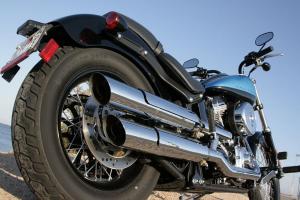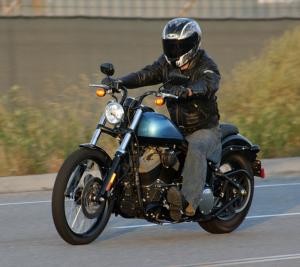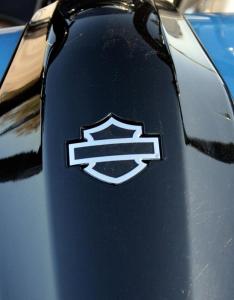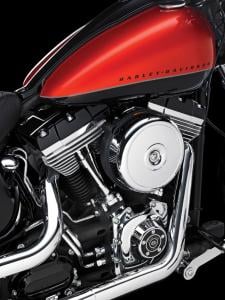With the 2011 Blackline Softail, Harley-Davidson continues to evolve its Dark Custom lineup.
Carved from various standard Harley models, the Dark Customs have taken on a bare knuckles attitude expressed through no-nonsense styling underscored by a minimalist ethos and lots of blacked-out finishes. The unstated directive Harley seems to operate from with this sub-line implies that The Motor Company wants to pay tribute to (while also capitalizing on) the many subcultures built around Harleys – like the bobber scene, for instance.
The new Blackline’s silhouette makes known the bike’s Softail heritage, but this latest model to join the Dark Custom series also sports a lot of the chopping and bobbing seen on the likes of the Forty-Eight, Nightster and Iron 883.
The Blackline’s abbreviated fenders, small, simplistic headlight and inconspicuous branding follow the lead of many of the Dark Custom bikes’ styling notes. A single instrument dial (a speedo with inlaid LCD that let’s a rider choose from tripmeter, odo, clock, gear position with digital tachometer or miles-to-empty) placed on the top triple-clamp is a departure from tank-mounted instruments found on the current line of Softails.
This downplaying of features is yet another indicator of the Blackline’s allegiance to the less-is-more credo of the Dark Customs.
Continuing the dark theme are black wheels, black fork legs, black headlight nacelle, black mirrors, black turn signals (with the rear set serving double duty as tail lights – first seen on the Nightster and implemented on the Iron 883 and Forty-Eight), black rear pulley, belt guard, rear fender struts, etc., etc. While the Blackline is fairly uniform to the blacked-out scheme, it doesn’t fully eschew chrome. The ‘Line’s air cleaner cover, brake pedal arm and lifter block cover are shiny, whereas these parts on the Sportster-based Darks are not.
A Barely Legal Harley
It’s possible the ‘Line is a bike Larry Flynt might find appealing.
When Harley designers and engineers finished crafting this bike, they decided to give it barely legal spacing between the mirrors – they just meet the DOT minimum requirements. The mirrors are attached to “split drag” handlebars that bring the rider’s hands unusually close together for a Harley, and also appear to push the bounds of allowable narrowness.
This scrunched-together look is a key styling cue on the Blackline and a direct nod to the current crowd of bobber bikes and builders that often flout the law with their rebel ways.
The other standout feature that doesn’t standout until you start looking is the unfashionably narrow rear tire. As Kevin Duke informed us from the Blackline’s unveiling in January of this year, Harley fitted a 144mm 16-inch bun out back, while a narrow 21-incher – more common cruiser fare – spins up front. As Kevin said in his report from the unveiling, this narrow back tire “is a middle finger to the tired fat-tire movement.”
Make sure to read the Blackline preview for more in-depth details and to hear insights from the Harley team that created the bike.
Feet Forward, Fists Inward and Forward, Go Feel Lawless
You’re usually a law-abiding citizen, but from the moment you plunk your hiney in the Blackline’s dished-out saddle hovering 26.1 inches off the ground – the lowest dual-saddle seat height Harley offers – you start to feel your inner rule-breaker emerge. Set your boots on the forward mounted pegs, lean forward to clasp those illegal-looking, narrowly spaced bars and let the thrust of the torque-biased Twin Cam 96B propel you down the road while bad thoughts of joining a subversive biker club slip into your mind.
At the first sight of the highway patrol or local deputy your wicked train of thought derails, snapping you back into reality, where you realize you’d much rather finish paying down the mortgage than running from The Man. But you get the picture.
Despite the committed-looking riding position, the Blackline offers a pretty comfortable perch. However, if you’re under, say, 5 feet 10 inches, or have an inseam less than 30 inches, you might feel like you’re stretching for either the bars or pegs. Possible stretch aside, all but the shortest riders will find flat-footing at a stop easy stuff. Where the ergos start to reveal a shortcoming is during freeway sessions, when the windblast at 80 mph can start to tax your grip on the bars.
Although the riding position isn’t as extreme as the fold some custom bikes put their riders into, the Blackline’s ergos can, depending on the rider’s stature, somewhat force the rider into that notorious C-shaped riding position that so wonderfully acts like a parachute catching a bunch of wind.
It was also during freeway stints that I noted how well damped the rear suspension was over most bumps, save for the big ones – like mutant expansion joints – that’ll have most any cruiser punting its rider off the seat. Now, about those mirrors…
While the style of the closely spaced mirrors is spot-on for a production-based bobbed bike, rearward view is compromised – to the point that I gained a new appreciation for the view provided by the mirrors on some sportbikes (we often deride sportbikes for their limited rearward view).
So limiting is the field of view in the Blackline’s mirrors that I often had to crane left or right while pulling my arm as inward as possible to see more of what was behind me. Harleys usually boast good mirror, um, performance, but this style-conscious set is borderline for-adornment-purposes-only.
The air-cooled big Twin is familiar stuff to those who’ve ridden the counterbalanced 96-incher, but it bears revisiting the many merits that’ve kept this engine in production for the last several model years. Prior to my Blackline ride it had been a while since my last trip aboard a big-bore Harley, and I found its smooth, torquey power is ready at a moment’s notice, regardless of gear selection or rpm, a pleasing and fun reminder of just what a good mill this engine is for a cruiser.
Power response from the trouble-free EFI isn’t instantaneous like perhaps on a modern sport-tourer or standard motorcycle, but the big flywheel effect in this Twin keeps the engine digging into its deep well of twisting force. Even while in top-gear at freeway cruising speeds the Twin Cam 96B propels the Blackline forward deliberately with respectable acceleration when your action at the twist grip says, “Gimme more! Now!” to the Milwaukee motor.
If cruisers in general have a well-known limiting factor, it’s lean-angle clearance, i.e. how far you can tip in to a turn before you hear and feel metal grinding on asphalt.
It doesn’t take much effort to auger the Blackline’s long footpeg feelers into concrete during a turn, but in fairness, the lean angle clearance didn’t strike me as excessively less than many low-slung cruisers I’ve bent through a corner, whether in the canyons or around town.
Also low effort is the Blackline’s steering. With fat rear tires as the ruling class for so long, it’s possible you’re not yet ready to embrace the appearance of that “skinny” rear tire. But trust us when we say the tire’s width lends favorably to handling.
With less rubber real estate out back, the Blackline requires less energy of the rider for initial steering input, and the bike doesn’t exhibit the desire to right itself mid-corner (like you have to fight the bike to hold its line in a turn) as many 200mm-plus rear tire cruisers tend to do. With a sizable span of 66.5 inches between wheel axles, and pretty relaxed steering geometry of 30 degrees of rake and 4.84 inches of trail, the Blackline’s neutral handling and willingness to steer belie its 683-pound curb weight.
Stopping performance, like the engine performance, is something regular Harley riders are accustomed to: sufficient power with an okay feel at the lever. But, give the front brake lever a hearty grab with all four fingers and the single caliper and disc will reel in this Dark Custom quickly enough.
Additionally, Harley has made ABS available to the Blackline – a feature usually the realm of a number of the company’s VRSC and touring models. Regrettably, optional ABS, that in 2010 normally added $845 to the MSRP of certain models, is now available on the Blackline only as part of the $1195 Security Package that includes proximity-fob keyless ignition. Package-only pricing follows this pattern where ABS is an option for select 2011 models.
Bobbed and Black is the New Game, But Only Two Want to Play
A black-as-sin Vivid Black Blackline retails for $15,499, while the Cool Blue Pearl/Vivid Black and Sedona Orange/Vivid Black have price tags marked $15,998. Incidentally, the color on these color options exists on about 3/4ths of the fuel tank – the rest of the scheme retains the black heart of the Dark Custom line.
Some might say the high-ish ape hanger-style bars and wide front tire on Victory’s High-Ball keep it from competing directly with the Blackline. Yet the High-Ball’s clear-as-day bobber inspiration fits the bill and says that Victory is interested in a share of the crowd shopping the Dark Customs.
A Harley model better fit to the High-Ball is the Dark Custom Cross Bones. Alas, we’ve good reason to believe the Cross Bones is off the map in H-D’s 2012 lineup.
The High-Ball is powered by Victory’s 106 cubic-inch, 6-speed Freedom 106 V-Twin. From Victory and Harley comparos we’ve done, we know that, while not as smooth as the silky Harley Twin-Cam engine, the Victory Twin produces a good bit more power at the wheel – like at least 20 hp and 20 ft-lbs more than the 96B Vee.
Then consider the High-Ball’s $13,499 MSRP. Furthermore, Victory is the only other major manufacturer of cruisers pursuing this bobbed theme at a production level.
Fair game says me.
Source : motorcycle.com
Carved from various standard Harley models, the Dark Customs have taken on a bare knuckles attitude expressed through no-nonsense styling underscored by a minimalist ethos and lots of blacked-out finishes. The unstated directive Harley seems to operate from with this sub-line implies that The Motor Company wants to pay tribute to (while also capitalizing on) the many subcultures built around Harleys – like the bobber scene, for instance.
The new Blackline’s silhouette makes known the bike’s Softail heritage, but this latest model to join the Dark Custom series also sports a lot of the chopping and bobbing seen on the likes of the Forty-Eight, Nightster and Iron 883.
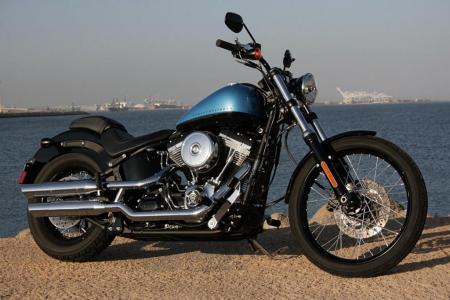 The 2011 Blackline Softail keeps the faith in Harley’s Dark Custom lineup. |
The Blackline’s abbreviated fenders, small, simplistic headlight and inconspicuous branding follow the lead of many of the Dark Custom bikes’ styling notes. A single instrument dial (a speedo with inlaid LCD that let’s a rider choose from tripmeter, odo, clock, gear position with digital tachometer or miles-to-empty) placed on the top triple-clamp is a departure from tank-mounted instruments found on the current line of Softails.
This downplaying of features is yet another indicator of the Blackline’s allegiance to the less-is-more credo of the Dark Customs.
Continuing the dark theme are black wheels, black fork legs, black headlight nacelle, black mirrors, black turn signals (with the rear set serving double duty as tail lights – first seen on the Nightster and implemented on the Iron 883 and Forty-Eight), black rear pulley, belt guard, rear fender struts, etc., etc. While the Blackline is fairly uniform to the blacked-out scheme, it doesn’t fully eschew chrome. The ‘Line’s air cleaner cover, brake pedal arm and lifter block cover are shiny, whereas these parts on the Sportster-based Darks are not.
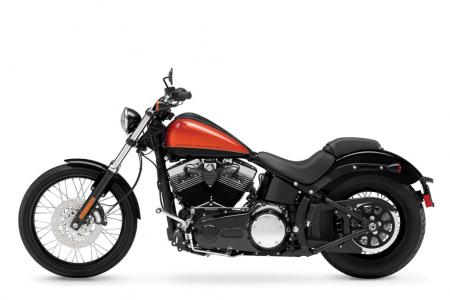 The Blackline goes heavy on the black, like all the Dark Custom bikes. |
A Barely Legal Harley
It’s possible the ‘Line is a bike Larry Flynt might find appealing.
When Harley designers and engineers finished crafting this bike, they decided to give it barely legal spacing between the mirrors – they just meet the DOT minimum requirements. The mirrors are attached to “split drag” handlebars that bring the rider’s hands unusually close together for a Harley, and also appear to push the bounds of allowable narrowness.
This scrunched-together look is a key styling cue on the Blackline and a direct nod to the current crowd of bobber bikes and builders that often flout the law with their rebel ways.
The other standout feature that doesn’t standout until you start looking is the unfashionably narrow rear tire. As Kevin Duke informed us from the Blackline’s unveiling in January of this year, Harley fitted a 144mm 16-inch bun out back, while a narrow 21-incher – more common cruiser fare – spins up front. As Kevin said in his report from the unveiling, this narrow back tire “is a middle finger to the tired fat-tire movement.”
Make sure to read the Blackline preview for more in-depth details and to hear insights from the Harley team that created the bike.
Feet Forward, Fists Inward and Forward, Go Feel Lawless
You’re usually a law-abiding citizen, but from the moment you plunk your hiney in the Blackline’s dished-out saddle hovering 26.1 inches off the ground – the lowest dual-saddle seat height Harley offers – you start to feel your inner rule-breaker emerge. Set your boots on the forward mounted pegs, lean forward to clasp those illegal-looking, narrowly spaced bars and let the thrust of the torque-biased Twin Cam 96B propel you down the road while bad thoughts of joining a subversive biker club slip into your mind.
At the first sight of the highway patrol or local deputy your wicked train of thought derails, snapping you back into reality, where you realize you’d much rather finish paying down the mortgage than running from The Man. But you get the picture.
Despite the committed-looking riding position, the Blackline offers a pretty comfortable perch. However, if you’re under, say, 5 feet 10 inches, or have an inseam less than 30 inches, you might feel like you’re stretching for either the bars or pegs. Possible stretch aside, all but the shortest riders will find flat-footing at a stop easy stuff. Where the ergos start to reveal a shortcoming is during freeway sessions, when the windblast at 80 mph can start to tax your grip on the bars.
Although the riding position isn’t as extreme as the fold some custom bikes put their riders into, the Blackline’s ergos can, depending on the rider’s stature, somewhat force the rider into that notorious C-shaped riding position that so wonderfully acts like a parachute catching a bunch of wind.
It was also during freeway stints that I noted how well damped the rear suspension was over most bumps, save for the big ones – like mutant expansion joints – that’ll have most any cruiser punting its rider off the seat. Now, about those mirrors…
While the style of the closely spaced mirrors is spot-on for a production-based bobbed bike, rearward view is compromised – to the point that I gained a new appreciation for the view provided by the mirrors on some sportbikes (we often deride sportbikes for their limited rearward view).
So limiting is the field of view in the Blackline’s mirrors that I often had to crane left or right while pulling my arm as inward as possible to see more of what was behind me. Harleys usually boast good mirror, um, performance, but this style-conscious set is borderline for-adornment-purposes-only.
The air-cooled big Twin is familiar stuff to those who’ve ridden the counterbalanced 96-incher, but it bears revisiting the many merits that’ve kept this engine in production for the last several model years. Prior to my Blackline ride it had been a while since my last trip aboard a big-bore Harley, and I found its smooth, torquey power is ready at a moment’s notice, regardless of gear selection or rpm, a pleasing and fun reminder of just what a good mill this engine is for a cruiser.
Power response from the trouble-free EFI isn’t instantaneous like perhaps on a modern sport-tourer or standard motorcycle, but the big flywheel effect in this Twin keeps the engine digging into its deep well of twisting force. Even while in top-gear at freeway cruising speeds the Twin Cam 96B propels the Blackline forward deliberately with respectable acceleration when your action at the twist grip says, “Gimme more! Now!” to the Milwaukee motor.
If cruisers in general have a well-known limiting factor, it’s lean-angle clearance, i.e. how far you can tip in to a turn before you hear and feel metal grinding on asphalt.
It doesn’t take much effort to auger the Blackline’s long footpeg feelers into concrete during a turn, but in fairness, the lean angle clearance didn’t strike me as excessively less than many low-slung cruisers I’ve bent through a corner, whether in the canyons or around town.
Also low effort is the Blackline’s steering. With fat rear tires as the ruling class for so long, it’s possible you’re not yet ready to embrace the appearance of that “skinny” rear tire. But trust us when we say the tire’s width lends favorably to handling.
With less rubber real estate out back, the Blackline requires less energy of the rider for initial steering input, and the bike doesn’t exhibit the desire to right itself mid-corner (like you have to fight the bike to hold its line in a turn) as many 200mm-plus rear tire cruisers tend to do. With a sizable span of 66.5 inches between wheel axles, and pretty relaxed steering geometry of 30 degrees of rake and 4.84 inches of trail, the Blackline’s neutral handling and willingness to steer belie its 683-pound curb weight.
Stopping performance, like the engine performance, is something regular Harley riders are accustomed to: sufficient power with an okay feel at the lever. But, give the front brake lever a hearty grab with all four fingers and the single caliper and disc will reel in this Dark Custom quickly enough.
Additionally, Harley has made ABS available to the Blackline – a feature usually the realm of a number of the company’s VRSC and touring models. Regrettably, optional ABS, that in 2010 normally added $845 to the MSRP of certain models, is now available on the Blackline only as part of the $1195 Security Package that includes proximity-fob keyless ignition. Package-only pricing follows this pattern where ABS is an option for select 2011 models.
Bobbed and Black is the New Game, But Only Two Want to Play
A black-as-sin Vivid Black Blackline retails for $15,499, while the Cool Blue Pearl/Vivid Black and Sedona Orange/Vivid Black have price tags marked $15,998. Incidentally, the color on these color options exists on about 3/4ths of the fuel tank – the rest of the scheme retains the black heart of the Dark Custom line.
Some might say the high-ish ape hanger-style bars and wide front tire on Victory’s High-Ball keep it from competing directly with the Blackline. Yet the High-Ball’s clear-as-day bobber inspiration fits the bill and says that Victory is interested in a share of the crowd shopping the Dark Customs.
A Harley model better fit to the High-Ball is the Dark Custom Cross Bones. Alas, we’ve good reason to believe the Cross Bones is off the map in H-D’s 2012 lineup.
The High-Ball is powered by Victory’s 106 cubic-inch, 6-speed Freedom 106 V-Twin. From Victory and Harley comparos we’ve done, we know that, while not as smooth as the silky Harley Twin-Cam engine, the Victory Twin produces a good bit more power at the wheel – like at least 20 hp and 20 ft-lbs more than the 96B Vee.
Then consider the High-Ball’s $13,499 MSRP. Furthermore, Victory is the only other major manufacturer of cruisers pursuing this bobbed theme at a production level.
Fair game says me.
Source : motorcycle.com
